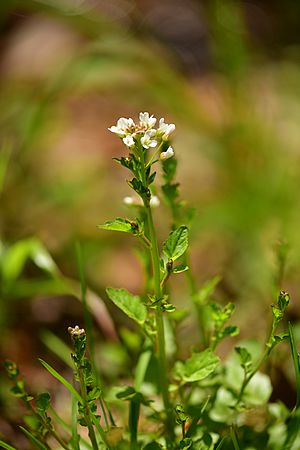Small-anthered bittercress facts for kids
Quick facts for kids Small-anthered bittercress |
|
|---|---|
| Conservation status | |
| Scientific classification | |
| Genus: |
Cardamine
|
| Species: |
micranthera
|
Cardamine micranthera is a very rare flowering plant. It is also known as the small-anthered bittercress or streambank bittercress. This plant belongs to the mustard family. You can only find it in a special area. This area is the Piedmont region. It is near the border between Virginia and North Carolina. Most of these plants live in the Dan River watershed.
This plant is in danger. Its home has been harmed or destroyed. For a while, people thought it was extinct. This was in the 1970s. But in the 1980s, it was found again! In 1989, the government listed it as an endangered species. Back then, only four small groups of plants were known. These were on private land that was not protected. Today, there are at least 20 known groups. This means there are over 20,000 plants in total.
Contents
What Does the Small-Anthered Bittercress Look Like?
This plant is a perennial herb. This means it lives for more than two years. It grows a thin stem. The stem can be 20 to 40 centimeters tall. That's about 8 to 16 inches. Sometimes, the stem branches out.
Its leaves grow one after another along the stem. Most of the leaves are simple. But the leaves near the bottom might have small parts called lobes.
Flowers and Fruit
Each flower has four small white petals. It also has stamens. These are the parts that make pollen. The stamens have tiny, round parts called anthers.
The fruit of this plant is a silique. This is a type of seed pod. It is about one centimeter long. That's less than half an inch.
You can tell this plant apart from its cousin, Cardamine rotundifolia. Cardamine micranthera has smaller, rounder anthers. Its petals are also smaller. And its fruits are shorter.
Where Does It Live?
This plant likes places that are wet and shady. You can find it near streams. It also grows in dim woodlands. This special habitat is around the North Carolina-Virginia border.
Why Is It in Danger?
The places where this plant lives have been changed a lot by people.
- Land Use: People have turned the land into pastures for animals. They also made it into farm fields and homes.
- Pollution: Water running off farms can carry chemicals. These chemicals can harm the plants. Herbicides used on farms can also drift over to the plant's habitat.
- Animals: Livestock like cows can walk on the plants. This can damage them.
- Water Changes: Wetlands have been changed. Their water flow has been controlled or moved.
- New Plants: Invasive plant species are a problem. For example, Japanese honeysuckle (Lonicera japonica) grows in the area. These new plants can take over. They can crowd out the native plants.
- Other Threats: Flooding and logging also threaten the plant. Logging means cutting down trees. This changes the shady habitat the plant needs.



